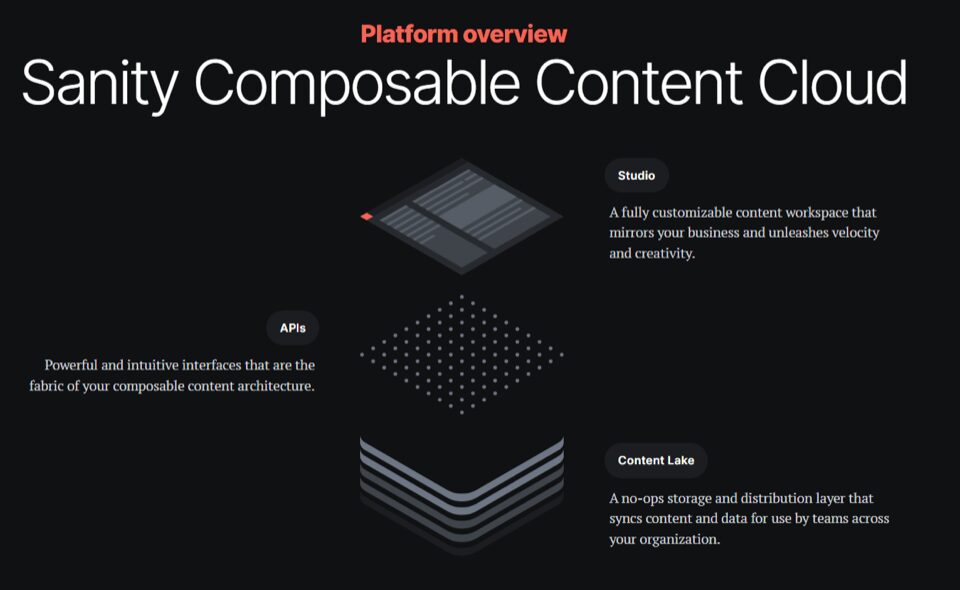
Table of Contents
What Makes a Great Headless CMS Platform?
A traditional content management system (CMS) is a tool that allows users to store, manage, and publish a variety of content types without ever needing to tinker with any code. This content delivery can be aimed at a single website (or multiple!) or an app. Traditional CMSs are essentially a bridge between your website’s front end and back end, and present a fairly low barrier to entry.
As great as that might sound, traditional CMSs are quickly becoming a relic in an age where businesses are looking for ways to build websites that can scale rapidly and handle sweeping changes without incurring downtime. A headless CMS disconnects the back end (where your content and data are stored) from the front end (the ‘head’ of your website – where that content is designed and presented). Here’s why it’s worth it.
- Flexibility: The best headless CMS platforms in 2024 give your designers and programmers the freedom to do their best work, without one having to worry about interfering with the other. Content management teams can build and manage a variety of content types while designers work simultaneously on delivering that content to a variety of platforms – all without the risk of breaking something.
- ROI: While shifting to a headless CMS platform can involve a learning curve and initial costs, the long-term return on investment is sizable. Businesses will naturally profit from working on a platform that doesn’t require time-consuming software updates and can keep up with an influx of new users.
- Performance: It just works better! 8 out of 10 businesses agree that shifting to a headless solution noticeably boosted website load speeds. Remember that having an optimized page naturally translates to lower bounce rates, and is a must-have for any business trying to grow.
- Security: A headless CMS platform has many advantages over a traditional CMS setup when it comes to security, especially when compared to SaaS like native BigCommerce or native Shopify. Some of the security advantages include:
- Reduced Attack Surface: The separation of the front end and back end reduces the attack surface. Attackers have fewer opportunities to exploit vulnerabilities, as there’s no direct link between the user interface and the data storage or business logic.
- Enhanced Security Updates and Patches: In a headless setup, it allows for quicker responses to security threats due to the full control over the code compared to something that is SaaS-based like Shopify or BigCommerce.
- Controlled Data Exposure: Since the back end and front end are separate, the exposure of data to the front end can be tightly controlled. APIs can be designed to expose only the necessary data, reducing the risk of data leaks.
- Robust Authentication and Authorization: Headless architectures often rely on modern, robust authentication mechanisms like OAuth and JWT (JSON Web Tokens), which enhance security.
- API Security: Headless architectures are heavily reliant on APIs, which can be secured with best practices such as rate limiting, encryption, and access controls.
- Better Compliance Posture: For businesses that need to comply with various data protection regulations, a headless architecture can make it easier to enforce compliance policies like GDPR/CCPA, HIPAA, and PCI DSS compliance, amongst others.
The Best Headless CMS Picks For 2024
WordPress
WordPress powers over 43% of the websites on the internet, and its popularity speaks for itself when it comes to ecommerce – but is it a good headless CMS platform?
Traditional WordPress’s familiarity as a CMS comes from its user-friendliness, being a platform with a unified back end and front end. Businesses often flock to the platform for its uniform user experience, allowing them to choose from a set list of plugins, themes, and design features. This worked well enough in the early and mid-2000s, but modern businesses demand an entirely new level of flexibility from their content management systems.
Headless WordPress fills in those gaps by giving developers the keys to the kingdom. At the cost of a higher learning curve and increased complexity, developers are free to scale their websites and redesign the front end as needed. This headless CMS platform’s flexibility benefits the end-user regardless of their device. GraphQL ensures that the same content is consistently delivered to users on desktops, mobiles, tablets, and wearables.

A storefront built on headless WordPress and BigCommerce
Storyblok
Storyblok is a popular choice because of its incredible UI, built from the ground up to support collaborations. With this CMS, you can:
- Work faster as a team with a powerful visual editor that supports live previews for code. Think Google Suite, but even more robust.
- Cloud-native support that allows developers to scale up with new features while maintaining high performance and security – without going through the hassle of repeated manual software updates.
- Easy management features that let admins assign custom roles to each user with granular controls.
Storyblok scores high on our list of the best headless CMS platforms in 2024 because of its emphasis on efficiency and UX over all else. In fact, some users have even gotten their first prototypes out in 2 days using Storyblok.
Contentful
Contentful has made a name for itself by making it even easier for developers to integrate it with just about any tech stack as an API-first headless CMS platform. As of 2024, this CMS now has the biggest market share for headless platforms. Some benefits include:
- Contentful Studio, an experience builder with AI-driven features that allow the platform to cut down further on code and focus more on delivering great content.
- Great localization features that, for instance, let creators work on completely unfamiliar languages with URL previews.
- A vibrant ecosystem that allows developers to connect with third-party services like Salesforce and Slack with just a click.
Shopify
As an established name in the ecommerce space, Shopify is an easy pick for one of the best headless CMSs in 2024. It delivers incredibly robust ecommerce functionality with a big focus on continual improvements and capability enhancements. Developers working with Shopify’s headless CMS will benefit from a powerful back-end infrastructure that is equipped to handle a massive user base. Here’s why headless Shopify is a good choice:
- Shopify’s headless CMS platform boasts some of the best cloud-based infrastructure on the market. Developers can make significant changes on the fly without having to worry about software updates breaking the website on certain devices.
- It supports GraphQL natively with no rate limits, meaning you get lightning-fast results on any plan without getting bottlenecked.
- Ships with the ability to use one of the best checkout conversion tools (Shop Pay) along with hundreds of payment gateways supported natively, so this is something you would not need to worry about.
- Powerful omnichannel selling capabilities are available right out of the gate to sell on GMC, Facebook/Meta, Amazon, Etsy, eBay, etc., without needing to custom-build integrations, as there are apps already available to use.
- Recent integration with RemixJS is also a huge boon for those working with Shopify. RemixJS is a very promising JS framework that helps developers create fast user experiences without having to consider things in the back end like data loading and code splitting.
- A rich ecosystem of Shopify design partners can help developers build unique storefronts.
- Great documentation, support, and many GitHub template repos are available to help you get started.
Sanity CMS
Sanity CMS differentiates itself from the other contenders on this list of the best headless CMS picks for 2024 by describing itself as more of a ‘composable content cloud.’ This means that it allows users to store just about any form of structured data instead of the text and media-based storage offered by other platforms. In addition:
- This CMS doesn’t ask for any predefined content types. Users have full control over the content schema they would like to use for development.
- Their Sanity Studio is a fully open-source environment that gives developers the freedom to collaborate on custom widgets, dashboards, and so much more.
- Real-time collaboration features allow admins to see which team members are working on which tasks, along with a handy revision feature that can roll back undesired changes.

Directus
In a word, this headless CMS platform is unopinionated. This means that Directus doesn’t try to force developers to use a predefined language or framework. It supports just about every popular tech stack from React to Vue.js, so users can pick it up and start building immediately.
While there is a cloud version of this platform available, it can also be self-hosted- meaning you can host it wherever you want! This feature can be a huge bonus for developers and enterprise clients who need more control over their systems. This essentially means you have more control over your hosting environment as well as pricing. Many headless CMS platforms have some type of pricing model that is measured by usage, such as X amount of GBs that can be uploaded to their servers, or only X amount of views per month, etc. If you self-host, you could potentially lower costs and remove these rate limitations.
Directus’s content editor deserves a special shout-out here as one of the best headless CMS features in 2024, especially for businesses working with a massive amount of images. It comes with a built-in metadata scraper, making it incredibly easy to search for and handle thousands of images.
Builder.io
Looking for something more budget-friendly? Builder.io is a great choice for those looking to migrate to a headless CMS platform on a budget. Their platform focuses heavily on their visual editor, allowing users to perform extensive A/B testing and publish pages with a single click. If you’ve already built a front end, you can migrate it effortlessly and continue building on top of it, and Builder.io will even migrate seamlessly with you if you decide to re-platform.
If you’re looking to go with Builder.io, you’ll be in great company. There are quite a few big players that use this platform such as:
- Fiverr
- Zapier
- Vimeo
BigCommerce
BigCommerce is similar to Shopify in that it brings a powerful ecommerce back end to the table. Developers and business owners alike will be happy to learn that BigCommerce works hand-in-hand with Vercel to provide Edge Network hosting on their platform. This collaboration combines site generation with server-side rendering to deliver an experience that is as fast as it is customizable.
As far as platforms go, BigCommerce is one of the best headless CMS choices in 2024 if you’re looking for reliability above all else. Their platform supports other CMSs mentioned on this list, like WordPress and Contentful, along with digital experience platforms like Bloomreach that allow stores to fully personalize their customer journeys.
As a headless CMS platform, BigCommerce also gives users the power to create and modify multiple storefronts from the same dashboard. This is great if you’re working with multiple brands or selling across different regions.
Build Your Perfect Website
Every pick from our best headless CMS for 2024 list brings something unique to the table. Determine what your business is looking for to make the right choice. If you’d like assistance building a website that is truly tailored to your business’s needs, reach out to Coalition Technologies for a free strategy review. Our expert developers know what it takes to build websites that can scale for success, combined with SEO strategies that can multiply revenue figures in under a year.


